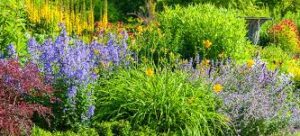Flower gardening is a delightful pursuit that brings vibrant colors and fragrances to your outdoor space. As we look forward to 2024, enhancing your flower garden to ensure it blooms beautifully all year round involves strategic planning, careful selection of plants, and attentive maintenance. Whether you’re a seasoned gardener or just starting, these top flower gardening tips will help you achieve a flourishing garden that offers stunning displays throughout the year.
1. Planning Your Flower Garden

1.1. Choose the Right Location
The success of your flower garden begins with choosing the right location. Consider the following factors:
- Sunlight: Most flowering plants thrive in full sun, which means they need at least 6-8 hours of direct sunlight daily. Some plants, however, prefer partial shade.
- Soil Quality: Well-draining soil is essential for healthy plant growth. Conduct a soil test to determine its pH and nutrient levels. Amend the soil as needed with compost or other organic matter.
- Water Accessibility: Ensure your garden has easy access to water. Drip irrigation systems or soaker hoses can be helpful in maintaining consistent moisture levels.
1.2. Plan for Seasonal Interest
To enjoy blooming beauty all year round, plan your garden with seasonal interest in mind:
- Spring Blooms: Choose early bloomers like daffodils, tulips, and crocuses to kick off the gardening season.
- Summer Color: Incorporate summer favorites such as roses, daylilies, and sunflowers for a vibrant display.
- Fall Foliage: Select plants that offer fall interest, like chrysanthemums and ornamental grasses.
- Winter Beauty: Include evergreen plants and winter-blooming varieties like hellebores to keep your garden looking attractive even in the colder months.
1.3. Design Your Garden Layout
Creating an aesthetically pleasing garden layout involves:
- Grouping Plants: Arrange plants in groups or clusters rather than planting them individually. This creates a more impactful display and makes maintenance easier.
- Layering: Use layering techniques to add depth to your garden. Place taller plants at the back, mid-sized plants in the middle, and ground covers or shorter plants in the front.
- Paths and Edging: Incorporate garden paths and edging to define spaces and provide easy access for maintenance.
2. Selecting the Best Flowers for Your Garden
2.1. Perennials vs. Annuals
- Perennials: These plants come back year after year, providing reliable color and texture. Examples include lavender, hostas, and peonies.
- Annuals: Annuals complete their life cycle in one year and need to be replanted each season. They offer a wide range of colors and can fill gaps in your garden. Popular choices are marigolds, petunias, and impatiens.
2.2. Native Plants
Incorporate native plants into your garden for several benefits:
- Adaptability: Native plants are well-suited to local soil and climate conditions.
- Low Maintenance: They often require less water and fertilizer compared to non-native species.
- Wildlife Support: Native plants provide essential habitats and food sources for local wildlife, including bees and butterflies.
2.3. Consider Bloom Time
To ensure continuous blooms, select flowers with varying bloom times:
- Early Bloomers: Examples include snowdrops and primroses.
- Mid-Season Bloomers: Roses and daisies offer vibrant color in the summer months.
- Late Bloomers: Sedums and asters extend the bloom season into fall.
3. Planting and Care Techniques
3.1. Soil Preparation
Proper soil preparation is key to a successful flower garden:
- Amend the Soil: Improve soil fertility and structure by adding compost or well-rotted manure.
- pH Adjustment: Adjust soil pH based on the needs of your chosen plants. Most flowering plants prefer a slightly acidic to neutral pH.
3.2. Planting Tips
- Timing: Plant flowers at the appropriate time for your region. Spring and fall are generally ideal for most plants.
- Spacing: Follow recommended spacing guidelines to prevent overcrowding and ensure proper air circulation.
- Depth: Plant flowers at the correct depth. Generally, the top of the root ball should be level with the soil surface.
3.3. Watering and Fertilizing
- Watering: Keep soil consistently moist but not waterlogged. Water early in the day to reduce evaporation and prevent fungal diseases.
- Fertilizing: Apply a balanced fertilizer according to the needs of your plants. Avoid over-fertilizing, as this can lead to excessive foliage growth at the expense of blooms.
3.4. Pruning and Deadheading
- Pruning: Regularly prune your plants to remove dead or diseased wood and encourage healthy growth. Prune back spent blooms to promote new flower production.
- Deadheading: Remove faded flowers to prolong blooming and prevent the plant from going to seed.
4. Pest and Disease Management
4.1. Identifying Common Pests
Common garden pests include aphids, spider mites, and slugs. Keep an eye out for signs of infestation such as:
- Chewed Leaves: Indicates feeding by pests like slugs or caterpillars.
- Sticky Residue: Often a sign of aphid activity.
- Spider Webs: May indicate a spider mite problem.
4.2. Disease Prevention
Prevent common plant diseases by:
- Avoiding Overhead Watering: This helps reduce fungal infections.
- Spacing Plants Properly: Good air circulation helps prevent mold and mildew.
- Using Disease-Resistant Varieties: Choose plants that are less susceptible to local diseases.
4.3. Organic Pest Control
Opt for organic pest control methods to maintain a healthy garden:
- Neem Oil: Effective against a variety of pests and diseases.
- Insecticidal Soap: Targets soft-bodied insects like aphids and whiteflies.
- Beneficial Insects: Introduce natural predators such as ladybugs and lacewings.
5. Seasonal Maintenance

5.1. Spring Preparation
- Clean Up: Remove dead leaves, twigs, and debris from your garden beds.
- Replant and Mulch: Replant any overwintered perennials and apply a fresh layer of mulch to retain moisture and suppress weeds.
5.2. Summer Care
- Regular Watering: Ensure plants receive adequate water, especially during hot spells.
- Weeding: Keep weeds under control to reduce competition for nutrients and space.
5.3. Fall Tasks
- Cut Back: Trim back spent foliage and flowers to prepare plants for winter.
- Mulch: Add a layer of mulch to protect plant roots from frost.
5.4. Winter Preparation
- Protect: Use mulch or protective covers for tender plants.
- Plan: Use the winter months to plan and research new additions or changes to your garden for the upcoming season.
6. Conclusion
Achieving a flower garden that blooms beautifully all year round involves thoughtful planning, careful plant selection, and attentive care. By incorporating these top flower gardening tips for 2024, you can create a vibrant and enchanting garden that offers continuous beauty throughout the seasons. From selecting the right flowers and preparing the soil to managing pests and seasonal maintenance, each step contributes to a thriving and picturesque garden. Embrace these strategies to enhance your gardening experience and enjoy a stunning display of flowers all year long.



